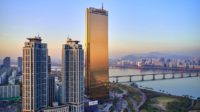Vancouver Convention Centre's Olympic Expansion
In comparison to the building boom that was the 2008 Beijing Olympics, the 2010 Vancouver Games have had little architectural fanfare: Most of the venues are existing stadiums, either left alone or slightly renovated. Even accounting for the lesser requirements of a Winter Games, the Olympics won’t leave much of an architectural stamp on their host city.


A 6-acre green roof tops a 338,000-square-foot addition to the Vancouver Convention Centre.
A notable exception is the large addition to the Vancouver Convention Centre (VCC) that opened on April 3. Designed by Seattle-based LMN Architects in association with Canadian firms Musson Cattell Mackey Partnership and DA Architects and Planners, the new structure will temporarily serve as the Vancouver 2010 International Broadcast Center, headquarters for the estimated 7,000 television and radio broadcasters and technicians who will cover the Games. They will occupy the building from this fall through the end of the Games (the Olympics are scheduled for February 12 to 28, followed by the Paralympic Games, March 12 to 21). Afterward, the building will be used for conventions, exhibitions, and other events.
The $720 million expansion adds 338,000 square feet of exhibition, meeting, and ballroom space to the existing 133,000-square-foot expo center—a distinctive, tensile-roof structure designed by DA Architects, Musson Cattell Mackey Partnership, and Zeidler Roberts Partnership and completed in 1986 for the World’s Fair. A 200-foot-long bridge connects the two buildings.
The expansion’s signature feature is its green roof: a 6-acre landscape of folding planes that is the largest of its kind in Canada. Other sustainable features include a system that uses the harbor’s seawater to heat and cool the building, grey and black water recycling, and a unique waterfront artificial reef that extends off the building’s north end into the Burrard Inlet. The reef structure, which resembles a grandstand descending into the water, has already attracted an array of sea life.
Sustainable initiatives were central to the project from its inception, according to Mark Reddington, a design partner at LMN. “Vancouver has a very community-focused process for making a project like this,” he says. “There’s a strong belief in protecting the natural environment and in sustainability in the general culture.” LMN worked with a number of local boards, including a city-appointed sustainability advisory committee that proposed environmental goals for the building. Reddington jokes that Vancouver could seem like the “world headquarters for community process,” but the result, he says, is a building that reflects the culture and ethos of the city.
The community was also instrumental in pushing for public access to the site, which takes up the equivalent of four city blocks. Throughways, a park, and retail storefronts define the edges of the new building, whose roof and connected landscape extend an emerald necklace of parks that sweeps around the harbor to the iconic Stanley Park, which lies directly to the northwest. Visually, the new building was intended to complement the iconic, sail-like roof of the older structure. “It makes the existing building stronger,” Reddington says, “because before we did this, the site was sort of a leftover piece of the waterfront that was incomplete.”


